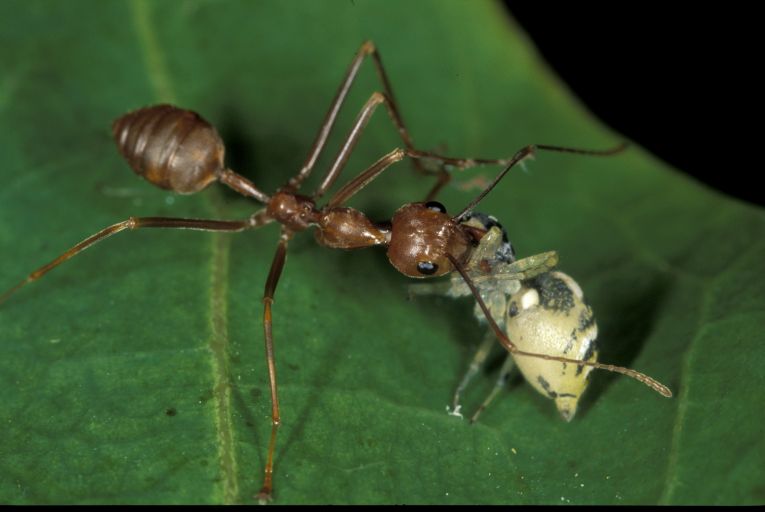When the associations between species are all accounted for, there have to be grounds for stealing from the worst fiction. We are only just realising how important the organisms we carry in our own bodies are to us. Here is an ant, a spider and then another spider. Simple, you would think. The intricate relationships are drawn out by a piece of research briefly shown in Behavioural Ecology and Sociobiology by Ximena J Nelson and Robert R Jackson of the University of Canterbury in Christchurch, NZ and ICIPE in Nairobi Kenya.
Myrmecophily means "liking ants," common in those creatures who like to snuggle into the giant nests of common species such as Formica rufa, the wood ant. Millipedes, beetles and even slow-worms are live-in guests. But the spiders who are guests of ants here are not strictly myrmecophile. They are often eaten by their hosts. They only stay near the protector ant because of their smell. This cloaks their spideriness and prevents another spider from finding them. The plot as well as the air thickens.
Phintea piantensis is a jumping spider that can escape capture well. Except that is when it is caught by the spitting spider, Scytodes sp. .Scytodes doesn't like the smell of the weaver ant Oecophylla smaragdina even though jumping spiders are one of its speciality prey. Protected by a dense silky nest, Phintea can escape the attentions of the ants, who can't penetrate its clever doorway.
The plot thickens. You could ask how the ant takes to the presence of Scytodes? These mixed species associations, studied here in the Philippines, live according to the, "mixed habitat hypothesis where species exploit each other for different reasons. Stealing food is common and mimics (known as Batesian mimics) can live alongside their poisonous models for extra protection. Here, a timid species, the Phintea, can benefit by nesting on waxy leaves near the "protector species," the weaver ant. Birds often do this but tropical ants and wasps function very well as protectors too.
The functioning of this system relies on the spitting spider's web being over the tiny Phintea's nests, which makes hunting it easier. If the Phintea sees active living weaver ants or even mounds of dead ants, it builds a nest. The tough dense weave of its nest has a hinge at each end that the spider flips open. Ants in pursuit are the problem, but they are left behind when the hinge closes the door quickly.
You could say spider technology beats the ants' teamwork and the spitting spiders' hunting ability - but not always! Next we'll have to look at the cunning nature of synechthry, when species live with ants but eat them instead of rewarding them.










